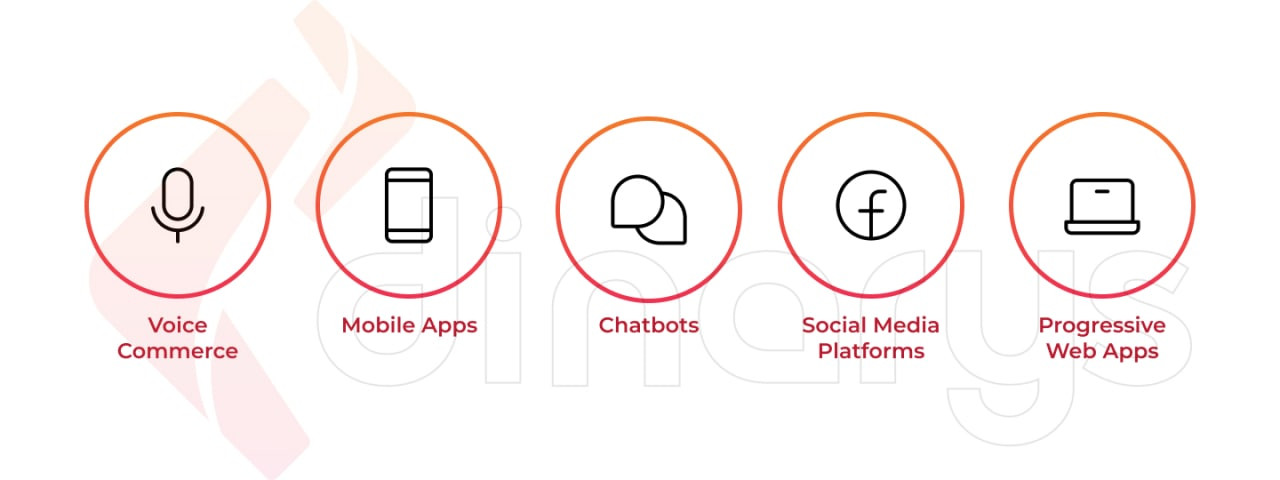Content
7 Benefits of Headless Commerce Strategy for Your Business

Time to read: 15 minutes
The traditional e-commerce approach, which uses a monolithic architecture in which the front end and back end connect, was once a popular choice for businesses. However, with changing customer needs and ever-evolving technologies, a headless commerce strategy has become an attractive alternative. Headless commerce is a modern technology architecture in which the front-end presentation layer (the storefront) is decoupled from the back-end system (the content management system). This approach allows companies to update their customer experience quickly and easily and ensures that their back-end processes are secure, fast, and reliable.
This article explores the seven benefits that a headless commerce strategy provides for your business. We also explain the difference between headless commerce and traditional commerce so that you can make an informed decision about the best approach for your business. Let’s dive in!
What Is Headless Commerce?
Headless commerce is an approach to building an e-commerce system that decouples the front-end and back-end components of a website. This allows companies to customize their customer experience with less effort and to present a more tailored experience for customers. This type of architecture supports multiple device types, simplifies customizations, and offers greater control over the interaction between the presentation layer and the back end.

Headless commerce stands in stark contrast to traditional e-commerce systems, which usually couple the front-end design and back-end management into a single entity, creating an all-inclusive solution for businesses. This type of system can be difficult to customize because any changes made to the presentation layer require changes to the back-end code.
For more information, read What Is Headless Commerce? Full Explanation Guide.
Comparison of Headless Commerce and Traditional Commerce
Headless commerce and traditional commerce are both web-based business models, but they differ significantly from each other. Headless commerce is a relatively new e-commerce model that separates the front-end user interface from the back-end systems. On the other hand, traditional commerce combines the two components into one platform.

Headless commerce and traditional commerce each have their own advantages, but they differ in several ways. Some of the key differences between headless commerce and traditional commerce include the following:
Architecture
Headless commerce is a modern architecture that decouples the front-end user experience from the back-end infrastructure. Consequently, changes to the user experience do not require changes to the back end and vice versa. On the other hand, traditional commerce has a more monolithic architecture in which all parts of the system are linked together, and any changes require an update to the entire system.
Scalability
Headless commerce is highly scalable due to its modular architecture, which allows for the rapid addition or removal of features without impacting other parts of the system. Traditional commerce systems can become cumbersome and slow to scale because of their monolithic architecture.
Flexibility
Headless commerce is highly flexible and customizable, allowing businesses to quickly adapt their online stores to changing customer needs. Traditional commerce systems are less flexible and can be too rigid to meet customers’ changing needs.
Integration
Headless commerce easily integrates with third-party services, such as payment gateways, shipping providers, and other e-commerce platforms. Traditional systems require more manual integration to enable these features.
Security
Headless commerce provides enhanced security because of its distributed architecture, which ensures that any changes are made in a secure environment. Traditional commerce systems have more centralized security, which can be vulnerable to potential attacks.
In sum, headless commerce offers businesses the flexibility and scalability they need to succeed in today’s rapidly changing digital landscape. It also provides an added layer of security and easily integrates with third-party services. Traditional headless commerce systems are effective, but they can be inflexible and slow to scale due to their monolithic architecture. It is important for businesses to evaluate the needs of their individual stores before deciding which system will work best for them.
Lets talk about itHave a project in mind?
Benefits of Headless Commerce
Headless commerce is an emerging trend in e-commerce that has gained significant momentum in recent years. It offers several advantages over traditional commerce, including scalability, faster performance, and improved security. Here are seven key benefits of headless commerce:
Customization
Customization is a major benefit of headless commerce that many retailers find attractive. With traditional commerce, customization can be difficult and expensive to implement. Headless commerce eliminates the need for complex coding but still allows retailers to customize the look and feel of their online stores, meet customer expectations, and create an enhanced shopping experience.
With headless commerce, retailers can quickly and easily modify the front ends of their stores using a variety of available APIs. This makes it easy to change different aspects of the website, such as colors, fonts, and layouts. In addition, with headless commerce, customers can personalize their shopping experiences based on items they have previously purchased or other criteria. This makes it easy to create a unique shopping experience tailored to each customer and to increase brand loyalty. Generally, customization is an important benefit of headless commerce because it can help retailers provide customers with a more enjoyable shopping experience.
Flexibility for Startups
Headless commerce is a great choice for startups because of its flexibility. Unlike traditional e-commerce systems, headless commerce allows developers to focus on the customer experience without worrying about complicated back-end infrastructure, which enables startups to rapidly iterate and improve their products in ways that are not possible with traditional e-commerce solutions. For example, a startup can quickly develop and launch new functionality with headless commerce to meet its customers’ changing needs. The ability to quickly adapt can be critical for startups trying to distinguish their offerings from established competitors.

Headless commerce also offers startups the capability to easily use the latest technology stack without worrying about compatibility issues. Therefore, startups can stay current with the latest trends and technology and quickly develop innovative solutions that capitalize on changing customer demands. Furthermore, headless commerce supports integration with third-party APIs and services, so startups can easily add new features and functionality for their customers. This flexibility ensures that startups remain competitive in a rapidly changing market.
Fast Web Performance
Headless commerce offers a major benefit over traditional commerce when it comes to web performance. By decoupling the back-end and front-end processes from each other, headless commerce provides lightning-fast page-loading speeds on sites that utilize this technology because it loads nonessential functions and large images in the background, allowing for a much faster response time. This is especially helpful for mobile sites, as users often expect fast loading times and quickly leave pages that take too long to load. In addition, this enables businesses to provide the best possible user experience on any device.

Headless commerce also allows more flexibility when businesses update their web designs because they can do so without affecting any of the back-end functions. Thus, businesses can keep their sites current with the latest trends in web design and still guarantee a fast and efficient user experience. In sum, headless commerce provides an invaluable benefit for any business looking to improve its web performance. With lightning-fast page-loading speeds and the ability to update designs without affecting any of the back-end functions, businesses can provide a better experience for users, regardless of the device they use.
Reduced Time-to-Market
Headless commerce makes it significantly easier and faster to launch new features because it decouples the back end (data) and front end (presentation layer), allowing developers to work independently of each other. This reduces the time to market for new features, which is especially useful in highly competitive markets where speed and agility are essential.
The traditional commerce model is tightly coupled, meaning that the data and presentation layers are connected. This requires developers to work in tandem when launching new features or updating existing features, which increases the time to market for new features. With headless commerce, developers can update each layer independently without having to worry about the other layer, allowing businesses to quickly launch new or updated features.

Headless commerce reduces the time-to-market, which greatly benefits businesses because it allows them to stay ahead of the competition and provide users with the latest technology. This increased agility helps businesses respond quickly to market changes and customer requirements, enabling them to better serve their customers, and it saves time and money by launching features faster with fewer headaches.
Best-of-Breed E-Commerce Solutions
Headless commerce enables businesses to choose from the best-of-breed e-commerce solutions available on the market and select software or services specifically suited to their needs, rather than settling for an all-in-one solution that may not meet all their requirements. With headless commerce, businesses can easily switch out or upgrade certain components of their e-commerce infrastructure to keep up with the latest trends. This keeps businesses competitive and gives them the freedom to choose solutions that are more suited to their particular needs and to create unique and personalized shopping experiences for their customers without sacrificing flexibility or scalability.

Headless commerce also provides businesses with greater control over their e-commerce infrastructure. Unlike traditional commerce systems, headless commerce does not require businesses to change their entire systems to make small adjustments. Instead, businesses can choose specific components to be upgraded or switched out, making it easier and more efficient for them to make any needed changes. This flexibility makes it simpler for businesses to make changes quickly, allowing them to keep up with the ever-evolving e-commerce landscape.
Lets talk about itHave a project in mind?
Unlimited User Experience/User Interface Control
One of the biggest advantages of headless commerce is that it provides unlimited control over the user experience (UX) and the user interface (UI). Without having a back end tied to the front end, retailers have complete freedom to create custom designs for their customers. Traditional commerce solutions often limit flexibility when it comes to UX/UI customization.

Headless commerce eliminates this constraint and allows retailers to fully control their customer’s experience. This allows retailers to tailor their designs to meet the specific needs of their target audiences and to create more personalized and engaging shopping experiences. In addition, headless commerce makes it easier to adjust design and functionality based on customer feedback or market trends, and it allows retailers to quickly adapt their designs and produce better products for their customers. Ultimately, headless commerce provides unlimited UX/UI control that businesses can use to create an optimal shopping experience for customers.
System Scalability
Because of its scalability, headless commerce is well suited to the dynamic digital landscape. The modular structure of headless commerce enables businesses to quickly scale their systems up or down, depending on their needs. This allows them to easily adapt and respond to changes in customer demand by adding new features or increasing capacity. Furthermore, because the system is built on standard APIs, adding new services and products to the platform can be done very quickly. Ultimately, this scalability ensures that businesses stay ahead of the competition in terms of speed and agility. With headless commerce, businesses can rapidly deploy resources when needed and implement processes that help them stay agile and competitive.

This ability to scale up or down quickly and easily makes it much simpler for businesses to offer customers a consistent experience regardless of changes in demand. Scaling can be difficult with traditional commerce because making changes requires complex integration with back-end systems and other applications. Headless commerce eliminates this complexity by allowing businesses to adapt and respond to customer needs and market trends more quickly.
Lets talk about itHave a project in mind?
Disadvantages of Headless Commerce
Headless commerce is a relatively new technology, and while it has many advantages, it also has some disadvantages that businesses should consider before switching from traditional commerce. Some of the key disadvantages of headless commerce include the following:
Complex Architecture
Headless commerce requires more complex architecture than traditional commerce systems. In addition, it requires specialized knowledge and technical experience to implement it correctly.
Limited Design Options
Headless commerce does not offer a wide range of design options or customization when compared to traditional commerce. If you are looking for something outside the box, headless commerce may not be the best option for you.
Higher Costs
Implementing headless commerce requires more resources and a larger budget than traditional commerce systems because it requires specialized development skills and expertise. It also requires additional maintenance costs for ongoing support.
Lack of Third-Party Integrations
As headless commerce is a relatively new technology, available third-party integrations are limited. Therefore, it may be harder to connect with other services and platforms, limiting the options you have when building your store.
Security Risks
As headless commerce is a new technology, there are still some security risks associated with its implementation. Additionally, as all systems must communicate through APIs, extra caution must be taken to ensure the security and privacy of information.
While headless commerce provides many advantages, it is important to weigh the disadvantages before making a decision. Ultimately, you want to ensure that you select the best option for your business that meets your needs and budget. Evaluating both the pros and cons of headless commerce will help you do this.
Headless Commerce Examples
Examples of headless commerce are becoming more prevalent as businesses search for ways to become more agile and flexible in their e-commerce operations. By decoupling the front-end presentation layer from the back-end technology, companies benefit from increased speed and scalability while allowing customers to access their products or services on any platform. Some examples of headless commerce include the following:
Voice Commerce
Customers can use voice assistants, such as Alexa and Google Home, to order products or services and enjoy hands-free shopping experiences.
Mobile Apps
Headless commerce enables companies to quickly create mobile apps that are tailored to their customers’ needs and thus offer a superior shopping experience.
Chatbots
Companies can use chatbots powered by AI technology to provide round-the-clock customer service, answer common questions, and help buyers find the right product quickly and easily.
Social Media Platforms
Headless commerce allows companies to sell their products on social media platforms, such as Instagram and Facebook, without having to invest in separate webstores.
VProgressive Web Apps
Progressive web apps are websites that have been optimized for mobile devices and that allow users to access the same information and features as a traditional website on any device.

As businesses strive to provide customers with the best possible shopping experience, headless commerce technology is quickly becoming an essential part of e-commerce operations. By leveraging the benefits of headless commerce, companies can build agile and flexible solutions that meet customer needs and remain competitive in an increasingly digital world.
Lets talk about itHave a project in mind?
Conclusion
Headless commerce is quickly becoming the preferred choice for many businesses. Its ability to connect easily with multiple digital channels and its seamless customer experience make it a valuable asset for organizations of all sizes. With headless commerce, businesses can keep pace with ever-changing customer demands and provide a unique experience that traditional commerce cannot match. The seven key benefits of composable commerce (another name of headless commerce you might stumble upon) previously discussed are just the beginning. Companies can reap more long-term rewards by leveraging this technology. Headless commerce is a powerful tool that can help businesses take advantage of the digital marketplace and stay ahead of their competition. With the scalability, flexibility, and customization options of headless commerce, it is no wonder that it is becoming such a popular choice.
Dinarys is committed to helping businesses experience the power of a headless commerce platform. Using our expertise and guidance, you can create a unique experience that will help your business stand out and succeed in this digital world. Contact us us today to learn more about the ways headless commerce can help you.
Lassen Sie Profis Ihre Herausforderung meistern
Unsere zertifizierten Spezialisten finden die optimale Lösung für Ihr Unternehmen.




